|
 |
Non-Water Hammer Check Valve
SL series (PAT.)
No valve closure delay means no water hammer and no noise
|
|
|
The YOKOTA Non-Water Hammer Check Valve is a high performance check valve
that safely and economically eliminates the danger of water hammer which
is a major problem in pumping and water supply equipment.
Mining of underground resources such as coal, from hundreds of meters underground
involved contending with a large amount of water. If a pump stopped operating
due to a power failure, intense water hammer would occur causing an accident
that could lead to pipe ruptures, pump damage, and even put the lives of
workers in danger.
The YOKOTA Non-Water Hammer Check Valve clearly solved this problem.
Since then, the valve has been widely adopted in many public facilities
such as water supply pumping plants, pumping stations, supply pipelines,
agricultural irrigation, and sewage systems. With buildings being built
higher and various types of equipment requiring higher pressure, a solution
to the water hammer problem has become increasingly important, and we have
developed a good reputation through our many achievements in this field.
Also, many of our clean-finished Non-Water Hammer Check Valves for ultra-pure
water are used in the semiconductor industry.
|

|
No water hammer
|
|
Due to the patented construction of the valve which opens and closes in
response to water flow, there is no delay in valve closure and water hammer
does not occur. The valve operates quietly and fits well into quiet surroundings.
|
|

|
Superior characteristics
|
|
Head loss of the valve is equivalent to JIS swing check valves and the
valve is adaptable to a variety of applications.
|
|

|
Easy to handle
|
|
Even the large valves feature simple, single-disk construction that eliminates
breakdowns so maintenance costs can be reduced considerably.
|
|

|
No-Feed Detector
|
|
The valve can be equipped with the accurate No-Feed Detector (except SL-UC, NU types) facilitating the safest possible automatic pumping.
|
|
Non-water hammer principle (PAT.) ....
|
The YOKOTA Non-Water Hammer Check Valve adjusts to the flow so that there
is no valve closure delay and water hammer does not occur.
|
|
Phenomenon of water hammer
|
|
In a pumping system without a check valve, when pump input stops suddenly,
the flow in the pipe goes through stages of "normal rotation, normal
flow", "normal rotation, reverse flow", and "reverse
rotation, reverse flow" and reaches a stable state. In such a case,
the maximum pressure increase reaches 150-160% of the total pump head,
which is comparatively small. However, check valves are normally installed
in actual pump systems, and the situation is entirely different.
|
|
Condition in pump immediately after power failure
(without check valve)
|
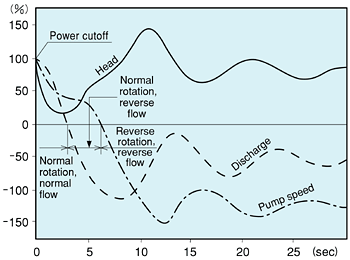
|
|
| Conventional check valves |
|
|
With conventional check valves, there is a tendency for valves to begin
to close only when pressed by reverse flow. Instantaneous stoppage of reverse
flow causes pressure to rise resulting in a water hammer noise similar
to striking a pipe with a hammer, and in some cases, this causes a blowout
in the discharge line.
|
|
|
Concept of the YOKOTA Non-Water Hammer Check Valve
|
|
|
|
| The YOKOTA Non-Water Hammer Check Valve |
|
|
Water hammer does not occur.
According to our patented non-water hammer principle, the valve disk of
the YOKOTA Non-Water Hammer Check Valve is designed to be submerged in,
and suspended by the water flowing in the pipes during maximum flow. When
normal flow begins to slow down, the valve disk begins to close in response
to this. The instant that flow reverses, in other words, when the water
in the pipe stops, the valve disk closes completely and water hammer does
not occur. This is similar to the shock eliminating effect of a ball that
is thrown upward and caught at the moment when it begins to fall.
|
|
Comparative test....Pressure change with time after pump operation is stopped
|
YOKOTA Non-Water Hammer Check Valve
|
Test equipment
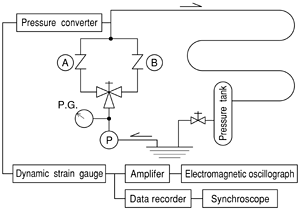
|
Type of pump:
|
Self-priming centrifugal pump
|
|
Pump specification:
|
12m3/h x 50m x 3500min-1 x 7.5kW
|
|
Discharge pipe:
|
40mm SGP13m
|
|
Recording paper feed rate:
|
50mm/sec
|
|
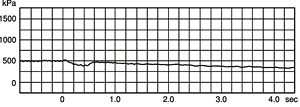
|
|
Conventional check valve
|
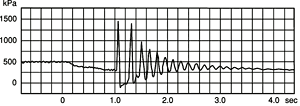
|
|
|
We are holding an "Online Exhibition" where you can experience
the same kind of tour as a real exhibition on the web.
In addition to the Non-Water Hammer Check Valve, we are exhibiting many
videos that are based on actual examples, including operation examples
of various pumps and valves such as defoaming/degassing pumps, and evaluation
methods of operation results.
(> "Online Exhibition" page) |
|
| Non-Water Hammer Check Valve SL series |
|
|
Example applications
|
|
|
|
For sewage treatment plants
|
|
For water purification plants
|
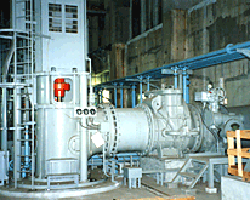
|
Sapporo City Sewage Department
SL-SH-1000
|
|
|
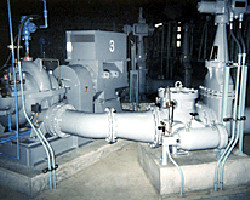
|
|
SL-SN-400B
|
|
|
|
|
|
|
|
|

|
|
SL-SH-600
|
|
|
|
|
The Kanmon Tunnel
SL-NBP-200 |
The Seikan Tunnel
SL-SN-300 (JIS 30K) |
|
|
|
|
|
|
|
|

|
|
SL-SN-150
|
|
|
|

|
Shrimp hatchery
SL-SN-200
|
|
|
|
|
|
|
|
For chemical/electronic industry
|
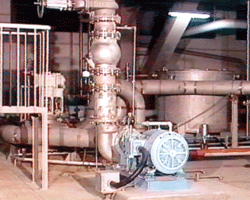
|
|
SL-NU-200
|
|
|
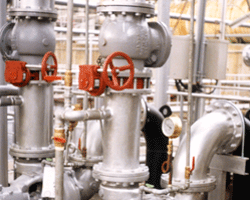
|
|
SL-SN-250
|
|
|
|
|
|
|
|
|

|
|
SL-NB-200
|
|
|
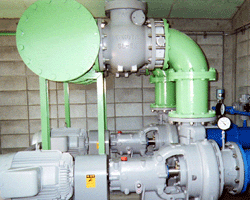
|
|
SL-SN-250
|
|
The valve can be applied for use with various kinds of liquid ranging from
pure water to seawater, contaminated water and chemical liquid as it can
be made from YOKOTA's duplex type stainless steel YST130N with high corrosion
resistance.
For details of YST130N, please refer to this page.
| Examples of non-water hammer pumping systems |
|
Solution to water hammer caused by recombined flow after water column separation
(Surge tank is not required because of patented non-water hammer principle)
|
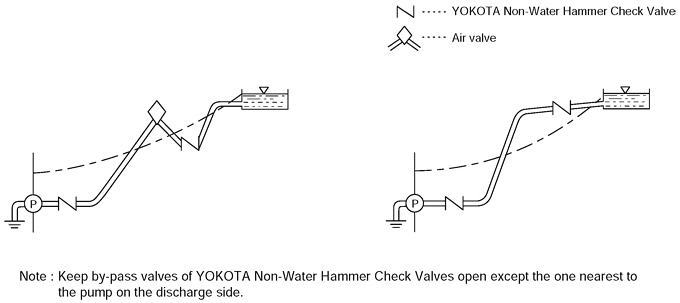
|
| Please note the following points when installing the Non-Water Hammer Check
Valve. |
|
1
|
Do not install with the discharge side facing downward.
|

|
|
2
|
Do not install with the discharge side facing downward.
|

|
|
3
|
SL-SN, SH types must not be installed in a leaning position.
|

|
|
4
|
The check valve must not be exposed to any deflected flow directly after
the pump or other valve.
|

|
|
5
|
If air is trapped in the pipe before the check valve, chattering may occur
when starting pump operation. Make sure to install an exhaust valve in
such cases.
|
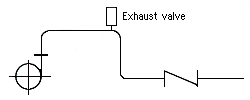
|
|
6
|
If the check valve on a submerged or vertical pump is installed at ground
level, the inlet side of the check valve may become a vacuum when the pump
is stopped and may cause water hammer. Carefully plan the location of the
check valve in such cases.
|
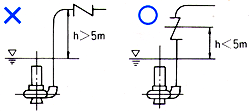
|
|
7
|
In addition to water hammer directly after the discharge of the pump, examine
surging due to negative pressure in the middle of piping. (Please contact
us for details.)
|

|
|
| SL series lineup / Selection chart & Outer dimensions |
|
|
>Back to Top |
|
|